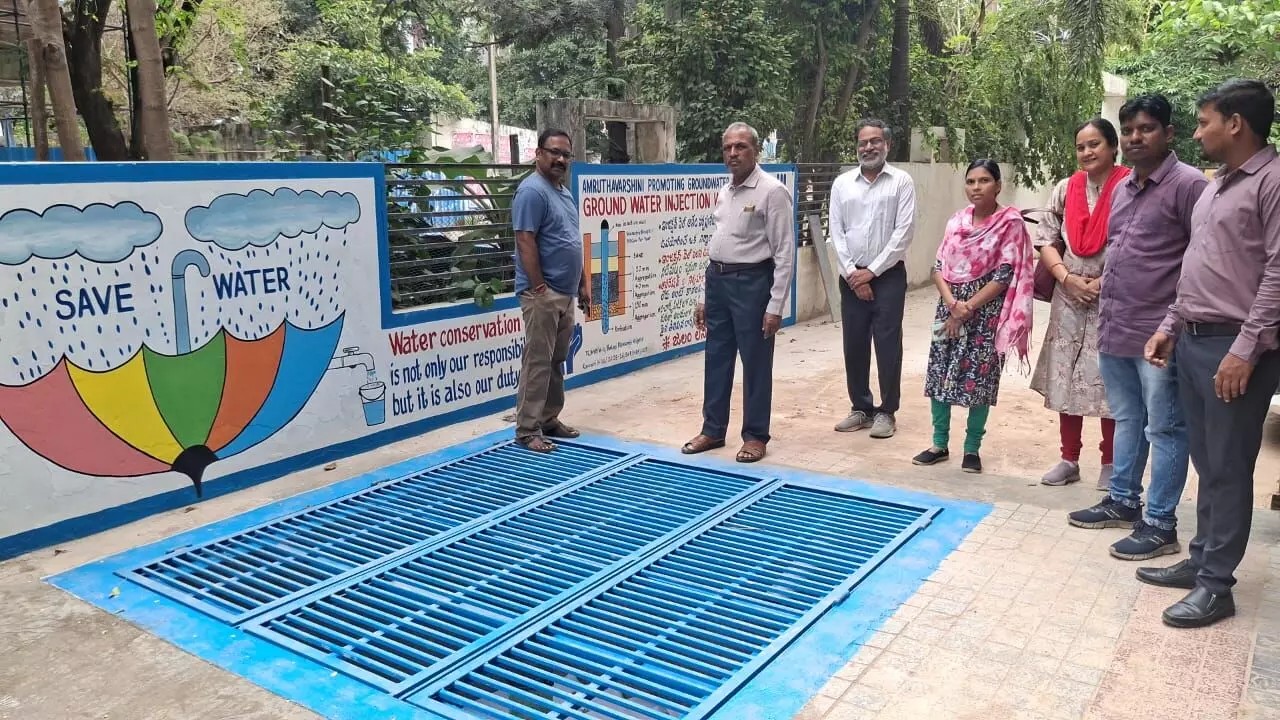Hyderabad: HMWSSB's ‘Every Home, One Pit’ drive boosts groundwater levels by up to 9 metres
In areas like Jeedimetla, Uppal, RC Puram and Kukatpally, groundwater has rebounded dramatically, reducing the burden on the city’s water distribution system
By - Sistla Dakshina Murthy |
Hyderabad: HMWSSB's ‘Every Home, One Pit’ drive boosts groundwater levels by up to 9 metres
Hyderabad: For a city long struggling with depleting groundwater and rising dependence on water tankers, Hyderabad’s renewed focus on rainwater harvesting has brought a breath of life underground.
The Hyderabad Metropolitan Water Supply and Sewerage Board’s (HMWS&SB) ‘Intinta Inkudu Guntha Yagnam’ — or Every Home, One Pit drive, is showing visible results, as groundwater levels have risen by up to nine meters in several areas this year.
Concrete jungle turns water-conscious
Once branded a “concrete jungle” where rainwater simply washed off into drains, Hyderabad is now scripting a turnaround story. Through systematic planning and large-scale participation, thousands of rainwater pits constructed in homes, apartment complexes, and offices are helping rainwater percolate into the soil instead of running off as waste.
This initiative, launched a year ago under the guidance of HMWS&SB Managing Director K Ashok Reddy, and inaugurated by Chief Minister A. Revanth Reddy and Minister Ponnam Prabhakar, was designed to promote rainwater harvesting as a mass movement across the metropolitan area.
Groundwater levels show sharp recovery
The results have been striking. Official groundwater department data reveals that water levels, which had plunged to depths between 14 and 28 meters last summer, have now improved to between 2 and 11 meters, registering an average rise of 3 to 9 meters across most zones.
The dual factors of above-normal monsoon rainfall (42% higher than average) and widespread adoption of rainwater harvesting pits are credited for this significant improvement. In areas like Jeedimetla, Uppal, RC Puram, and Kukatpally, groundwater has rebounded dramatically, reducing the burden on the city’s water distribution system.
Tankers lose relevance as borewells fill up
A direct outcome of this recharge effort has been the visible decline in the demand for private water tankers. According to HMWS&SB data, tanker bookings have dropped between 12 and 50 percent in multiple divisions, with areas such as Vinaynagar, Durgam Cheruvu, Kukatpally, LB Nagar, and Kapra-Uppal recording the steepest fall.
Residents who once relied on tankers for basic household needs now report sufficient water availability from their own borewells, a sign that the initiative is succeeding at the grassroots level.
Mandatory pits for all large homes
To institutionalize this progress, the HMWS&SB has made it mandatory for all residential plots larger than 300 square meters to construct rainwater harvesting pits. The Board has written to GHMC and municipal bodies to ensure strict implementation.
During inspections, officials identified over 42,000 premises that booked more than 20 tankers a month and issued 16,196 notices to those found without harvesting pits. To strengthen monitoring, 182 inspection teams and 18 NGOs have been deployed to oversee the drive and create awareness among citizens.
Unused borewells are also being converted into “injection wells” to facilitate direct groundwater recharge.
Saving crores, securing the future
“Every home that builds a rainwater pit is adding a lifeline for the city’s future,” Ashok Reddy said. “If every household participates, Hyderabad may not need another major drinking water project like Krishna Phase–IV. The rainwater we lose to drains each year can be redirected into the ground reducing our dependence on distant reservoirs and saving crores in transportation and treatment costs,” he explained.
Officials say that with groundwater replenishment, the need for tankers will continue to decline, ensuring that treated water from reservoirs is reserved exclusively for drinking purposes.
Turning rain into a resource
Though Hyderabad receives an annual average rainfall of 85 to 89 centimeters, less than one percent of it has historically seeped into the ground. The ‘Every Home, One Pit’ mission aims to reverse this trend by ensuring that a significant portion of rainfall percolates into the earth — recharging wells and restoring aquifers citywide.
Key gains of the ‘Rainwater Pit Yagna’
Groundwater levels up by 3–9 meters across several divisions.
Tanker demand is down by up to 50 percent.
Over 16,000 notices issued to premises without pits.
182 teams and 18 NGOs deployed for awareness and enforcement.
Initiative launched under Chief Minister A Revanth Reddy’s water sustainability vision.
A call to Citizens
The HMWS&SB has urged every resident to treat rainwater harvesting as a shared civic responsibility. “If every household captures rainwater and lets it percolate into the ground, there will be no shortage for daily needs,” said Ashok Reddy. “It’s not just about saving water, it’s about restoring balance beneath our feet.”